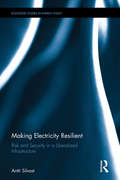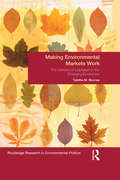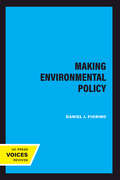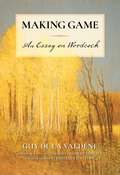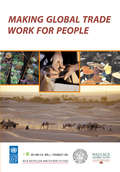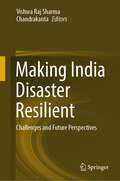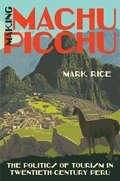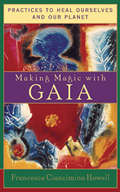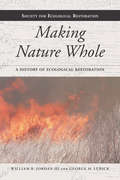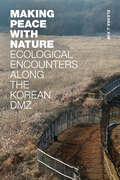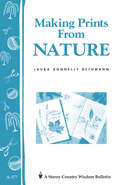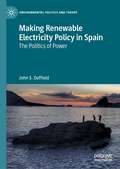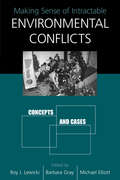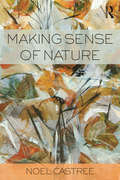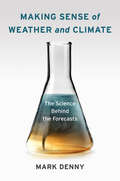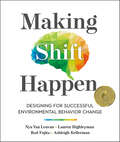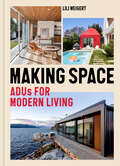- Table View
- List View
Making Electricity Resilient: Risk and Security in a Liberalized Infrastructure (Routledge Studies in Energy Policy)
by Antti SilvastEnergy risk and security have become topical matters in Western and international policy discussions; ranging from international climate change mitigation to investment in energy infrastructures to support economic growth and more sustainable energy provisions. As such, ensuring the resilience of more sustainable energy infrastructures against disruptions has become a growing concern for high-level policy makers. Drawing on interviews, participant observation, policy analysis, and survey research, this book unpacks the work of the authorities, electricity companies, and lay persons that keeps energy systems from failing and helps them to recover from disruptions if they occur. The book explores a number of important issues: the historical security policy of energy infrastructures; control rooms where electricity is traded and maintained in real time; and electricity consumers in their homes. Presenting case studies from Finland and Scandinavia, with comparisons to the United States, the United Kingdom, and the European Union at large, Making Electricity Resilient offers a detailed and innovative analysis of long-term priorities and short-term dynamics in energy risk and resilience. This book will be of great interest to students and scholars of energy policy and security, and science and technology studies.
Making Environmental Markets Work: The Varieties of Capitalism in Emerging Economies (Environmental Politics)
by Tabitha M. BenneyPerhaps the most defining characteristic of the global economy today is the rise of emerging market economies (EMEs). Many states have experienced rapid economic growth over the past two decades that has led to an increasing share of global wealth. Such dramatic changes are highly relevant because they raise important issues about the distribution of global monetary and fiscal power. As the EMEs have gained importance in the global economy, their influence and significance have grown across a wide range of policy domains. One particularly relevant example is the increasingly critical role of EMEs in addressing climate change. Contrary to the popular belief that the level of development determines a country’s ability to produce positive environmental outcomes, this book shows that the variation in environmental outcomes among the EMEs is due to differences in the types of economic institutions prevalent in their economies. Since EMEs differ dramatically on a number of variables, examining national variations in economic institutions helps explain why international climate policy has been more successful in some countries than in others. To assess how variations in capitalism may influence important outcomes, this book explores a representative sample of 31 EMEs and employs a mixed method research design that incorporates both conventional regression analysis and Qualitative Comparative Analysis (QCA) to explain these outcomes. The analysis shows that although liberal market economies were expected to perform better than other types of capitalism, their performance fell below expectations. On the contrary, economic institutions related to coordinated types of capitalism (like those found in China and Brazil) have led to greater Clean Development Mechanism (CDM) market participation. Theoretically informed, this book employs innovative ways of understanding a broad set of increasingly important but under studied states in an effort to highlight the interactions found in complex socio-political and ecological systems. With the growing importance of the EMEs, a better understanding of how to design market-based policies with them in mind will be required if future efforts across a range of policy issues are to be meaningful and effective.
Making Environmental Policy
by Daniel J. FiorinoWho speaks for the trees, the water, the soil, and the air in American government today? Which agencies confront environmental problems, and how do they set priorities? How are the opposing claims of interest groups evaluated? Why do certain issues capture the public's attention?In Making Environmental Policy, Daniel Fiorino combines the hands-on experience of an insider with the analytic rigor of a scholar to provide the fullest, most readable introduction to federal environmental policymaking yet published. A committed environmental advocate, he takes readers from theory to practice, demonstrating how laws and institutions address environmental needs and balance them against other political pressures.Drawing on the academic literature and his own familiarity with current trends and controversies, Fiorino offers a lucid view of the institutional and analytic aspects of environmental policymaking. A chapter on analytic methods describes policymakers' attempts to apply objective standards to complex environmental decisions. The book also examines how the law, the courts, political tensions, and international environmental agencies have shaped environmental issues. Fiorino grounds his discussion with references to numerous specific cases, including radon, global warming, lead, and hazardous wastes. Timely and necessary, this is an invaluable handbook for students, activists, and anyone wanting to unravel contemporary American environmental politics.
Making Game: An Essay on Woodcock
by Guy de la ValdèneGuy de la Valdène&’s beautifully written essay (and first book) is an ode to an iconic bird, part natural history, and part hunting memoir. It&’s a well-regarded and undisputed classic—an edgy, elegant examination of the habits and history of a reclusive gamebird, the Woodcock, native to Europe and North America, a bird that&’s been hunted and celebrated since Roman times. Valdène writes exuberantly of the bird, the hunt, and the feast, gracefully balancing the obsessions of a naturalist, sportsman, and gourmand.
Making Global Trade Work for People
by Kamal MalhotraThe world's trade regime is promoted by international agencies and most governments as the best way to lift the poor out of poverty and achieve sustainable development. But does it contribute to human development or not? This reassessment looks in detail at the way it has worked under the GATT and under the World Trade Organization, and analyses how it is working and how it can be improved. The book aims to make major contribution to the debates surrounding globalization and the impact of trade on the poor, on social stability and on the environment. It is intended to provide a benchmark for future policy discussion and analysis.
Making India Disaster Resilient: Challenges and Future Perspectives
by Chandrakanta Vishwa Raj SharmaVarious natural and man-made hazards are nowadays increasingly considered as disasters, particularly by individual and communities are lacking in awareness and where a system as a whole has no adequate management mechanism. Consequently, the world is facing serious negative outcome in form of loss of life, injury, disability, loss of property, infrastructure, and economic disruption followed by psycho-social disorders. Other than this, disasters adversely affect wildlife and environment in long terms. Developing countries are worst sufferers as these regions are poorly prepared for potential hazards at one hand and are exposed to disasters due to the complexity of (socio-cultural, economic and physical) vulnerability. Government, World communities, NGOs are recognizing the problems and are trying to build resilient communities to reduce disaster impact at various levels.Year 1990-99 was observed as the decade for natural disaster reduction by United Nations (UN) and United Nations International Strategy for Disaster Reduction (UNISDR) was established to support and coordinate this movement. Year 2015 has been very important in the history as three global agreements have been signed by global communities (Sustainable development goals, Paris agreement and Sendai framework for DRR). Where, SDGs are extension of MDGs to make the planet more sustainable. It proposed 17 goals and 15 years’ time frame adopted in the year 2015. SDGs target various social, cultural, economic, challenges followed by wildlife, environmental protection through knowledge share and technological innovation among all member countries. In December 2015, UNFCCC reached a landmark agreement to combat climate change and to accelerate and intensify the actions and investments needed for a sustainable low carbon future known as Paris agreement. Sendai Framework 2015 is voluntary, non-binding agreement which recognizes that the state has the primary role to reduce disasterrisk but that responsibility should be shared with other stakeholders including local government, the private sector and other stakeholders. This framework focuses on the pre-disaster management rather than post disaster relief and recovery. This book is an insight into the various issues related to the emerging disasters (both natural and man-made), vulnerable communities, and government initiatives taken with a geographical focus on India. This volume contains selected chapters written by faculty and research scholars. This book is an empirical work on disasters vulnerabilities and management which will benefit researchers, academicians, professional, practitioners and policy makers.
Making Machu Picchu: The Politics of Tourism in Twentieth-Century Peru
by Mark RiceSpeaking at a 1913 National Geographic Society gala, Hiram Bingham III, the American explorer celebrated for finding the "lost city" of the Andes two years earlier, suggested that Machu Picchu "is an awful name, but it is well worth remembering." Millions of travelers have since followed Bingham's advice. When Bingham first encountered Machu Picchu, the site was an obscure ruin. Now designated a UNESCO World Heritage Site, Machu Picchu is the focus of Peru's tourism economy. Mark Rice's history of Machu Picchu in the twentieth century—from its "discovery" to today's travel boom—reveals how Machu Picchu was transformed into both a global travel destination and a powerful symbol of the Peruvian nation.Rice shows how the growth of tourism at Machu Picchu swayed Peruvian leaders to celebrate Andean culture as compatible with their vision of a modernizing nation. Encompassing debates about nationalism, Indigenous peoples' experiences, and cultural policy—as well as development and globalization—the book explores the contradictions and ironies of Machu Picchu's transformation. On a broader level, it calls attention to the importance of tourism in the creation of national identity in Peru and Latin America as a whole.
Making Magic with Gaia: Practices to Heal Ourselves and Our Planet
by Francesca Ciancimino HowellThe author of Food, Festival and Religion shows how spiritual practices drawn from the ancient magical arts can help to heal Mother Earth. A Greenpeace activist, Wiccan High Priestess, and proud Soccer Mom, Francesca Howell has been involved in magical traditions and wildlife preservation since childhood. In this one-of-a-kind book, she shares her everyday suggestions for spiritual renewal through connecting with nature. The meditations, ceremonies, and spellcraft in Making Magic with Gaia spring from an ancient Pagan tradition of Earth stewardship, which blends deep ecology, magic, and activism to bring the reader into a closer communion and harmony with Mother Earth. Packed with practical suggestions (recycling, gardening without pesticides, and conserving water) and mystical rituals (shamanism, crystal magic, and Power Animals) for helping the planet, this book is written for anyone with a spiritual ecological awareness. Not the witchcraft of Gothic novels, Making Magic with Gaia is based on a modern religion with ancient roots that can heal the Earth as it heals the practitioner.
Making Nature Whole: A History of Ecological Restoration (Science Practice Ecological Restoration)
by William R. Jordan III George M. LubickMaking Nature Whole is a seminal volume that presents an in-depth history of the field of ecological restoration as it has developed in the United States over the last three decades. The authors draw from both published and unpublished sources, including archival materials and oral histories from early practitioners, to explore the development of the field and its importance to environmental management as well as to the larger environmental movement and our understanding of the world. Making Nature Whole is a landmark contribution, providing context and history regarding a distinctive form of land management and giving readers a fascinating overview of the development of the field. It is essential reading for anyone interested in understanding where ecological restoration came from or where it might be going.
Making Peace with Nature: Ecological Encounters along the Korean DMZ
by Eleana J. KimThe Korean Demilitarized Zone (DMZ) has been off-limits to human habitation for nearly seventy years, and in that time, biodiverse forms of life have flourished in and around the DMZ as beneficiaries of an unresolved war. In Making Peace with Nature Eleana J. Kim shows how a closer examination of the DMZ in South Korea reveals that the area’s biodiversity is inseparable from scientific practices and geopolitical, capitalist, and ecological dynamics. Drawing on ethnographic fieldwork with ecologists, scientists, and local residents, Kim focuses on irrigation ponds, migratory bird flyways, and land mines in the South Korean DMZ area, demonstrating how human and nonhuman ecologies interact and transform in spaces defined by war and militarization. In so doing, Kim reframes peace away from a human-oriented political or economic peace and toward a more-than-human, biological peace. Such a peace recognizes the reality of war while pointing to potential forms of human and nonhuman relations.
Making Prints from Nature: Storey's Country Wisdom Bulletin A-177
by Laura Donnelly BethmannSince 1973, Storey's Country Wisdom Bulletins have offered practical, hands-on instructions designed to help readers master dozens of country living skills quickly and easily. There are now more than 170 titles in this series, and their remarkable popularity reflects the common desire of country and city dwellers alike to cultivate personal independence in everyday life.
Making Renewable Electricity Policy in Spain: The Politics of Power (Environmental Politics and Theory)
by John S. DuffieldThis book examines the politics of renewable electricity policy in democratic Spain. It provides the first comprehensive political analysis of how and why successive Spanish governments have increased or reduced support for renewable power, especially wind and solar. In particular, it identifies the key influences that have been brought to bear on decision making by the core executive as it has sought to determine the appropriate role of renewable sources in the country’s electricity mix. Following the introduction, four chapters chart the dramatic rise, fall, and, most recently, renewed rise in support for utility-scale renewable power, from the early 1980s to the present. Another chapter details the decade-long political struggle over the regulation of small-scale distributed renewable electricity generation. The penultimate chapter explores the future prospects for renewable power in Spain, and the final chapter offers an overarching explanation of the patterns of policy outcomes observed.
Making Sense of Intractable Environmental Conflicts: Concepts And Cases
by Barbara Gray Roy Lewicki Michael ElliottDespite a vast amount of effort and expertise devoted to them, many environmental conflicts have remained mired in controversy, stubbornly defying resolution. Why can some environmental problems be resolved in one locale but remain contentious in another, often carrying on for decades? What is it about certain issues or the people involved that make a conflict seemingly insoluble?Making Sense of Intractable Environmental Conflicts addresses those and related questions, examining what researchers and experts in the field characterize as "intractable" disputes--intense disputes that persist over long periods of time and cannot be resolved through consensus-building efforts or by administrative, legal, or political means. The approach focuses on the "frames" parties use to define and enact the dispute--the lenses through which they interpret and understand the conflict and critical conflict dynamics.Through analysis of interviews, news media coverage, meeting transcripts, and archival data, the contributors to the book examine the concept of framing and the role that it plays in conflicts; outline the essential characteristics of intractability and its major causes; offer case studies of eight intractable environmental conflicts; present a rich body of original interview material from affected parties; and set forth recommendations for intervention that can help resolve disputes.Within each case chapter, the authors describe the historical development and fundamental nature of the conflict and then analyze the case from the perspective of the key frames that are integral to understanding the dynamics of the dispute. They also offer cross-case analyses of related conflicts. Conflicts examined include those over natural resource use, toxic pollutants, water quality, and growth.
Making Sense of Nature
by Noel CastreeWe listen to a cacophony of voices instructing us how to think and feel about nature, including our own bodies. The news media, wildlife documentaries, science magazines, and environmental NGOs are among those clamouring for our attention. But are we empowered by all this knowledge or is our dependence on various communities allowing our thoughts, sentiments and activities to be unduly governed by others? Making Sense of Nature shows that what we call ‘nature’ is made sense of for us in ways that make it central to social order, social change and social dissent. By utilising insights and extended examples from anthropology, cultural studies, human geography, philosophy, politics, sociology, science studies, this interdisciplinary text asks whether we can better make sense of nature for ourselves, and thus participate more meaningfully in momentous decisions about the future of life – human and non-human – on the planet. This book shows how ‘nature’ can be made sense of without presuming its naturalness. The challenge is not so much to rid ourselves of the idea of nature and its ‘collateral concepts’ (such as genes) but instead, we need to be more alert to how, why and with what effects ideas about ‘nature’ get fashioned and deployed in specific situations. Among other things, the book deals with science and scientists, the mass media and journalists, ecotourism, literature and cinema, environmentalists, advertising and big business. This innovative text contains numerous case studies and examples from daily life to put theory and subject matter into context, as well as study tasks, a glossary and suggested further reading. The case studies cover a range of topics, range from forestry in Canada and Guinea, to bestiality in Washington State, to how human genetics is reported in Western newspapers, to participatory science experiments in the UK. Making Sense of Nature will empower readers from a wide range of fields across the social sciences, humanities and physical sciences.
Making Sense of Weather and Climate: The Science Behind the Forecasts
by Mark DennyHow do meteorologists design forecasts for the next day's, the next week's, or the next month's weather? Are some forecasts more likely to be accurate than others, and why? Making Sense of Weather and Climate takes readers through key topics in atmospheric physics and presents a cogent view of how weather relates to climate, particularly climate-change science. It is the perfect book for amateur meteorologists and weather enthusiasts, and for anyone whose livelihood depends on navigating the weather's twists and turns. Making Sense of Weather and Climate begins by explaining the essential mechanics and characteristics of this fascinating science. The noted physics author Mark Denny also defines the crucial differences between weather and climate, and then develops from this basic knowledge a sophisticated yet clear portrait of their relation. Throughout, Denny elaborates on the role of weather forecasting in guiding politics and other aspects of human civilization. He also follows forecasting's effect on the economy. Denny's exploration of the science and history of a phenomenon we have long tried to master makes this book a unique companion for anyone who wants a complete picture of the environment's individual, societal, and planetary impact.
Making Shift Happen: Designing for Successful Environmental Behavior Change
by Nya Van Leuvan Lauren Highleyman Rod Fujita Ashleigh KellermanNautilus Book Award Winner: An “engagingly written” behavioral science-based guide to tackling our urgent environmental problems (Robert B. Cialdini, author of Influence: The Psychology of Persuasion).To create a sustainable future and achieve positive, durable change, we must design solutions based directly on how people think, make decisions, and act. From hotels that save water (and money) using simple signage to energy suppliers that boost participation in renewable energy programs through mere enrollment-form tweaks, it’s clear that shifting the behavior of millions for the better is possible.Based on decades of research into what drives behavior change, Making Shift Happen provides a suite of powerful tools to transform the world. It features A-to-Z guidance on how to design a behavior change initiative—from choosing the right audience and uncovering what drives their behavior to designing, prototyping, testing, and implementation. Clear instructions and real-world examples empower you to apply hundreds of behavioral science solutions including:Using social norms to spread positive environmental behaviorsSelecting and testing stories, metaphors, and values to frame information for each audienceCatalyzing action by aligning your initiative with your audience’s personal and social motivatorsBreaking bad habits and building positive onesCapturing your audience’s attention and reducing barriers to actionConnecting people with nature and building empathy for the environment and its inhabitantsMaking Shift Happen is a must-have guide for practitioners in non-profits, governments, and businesses looking to design successful campaigns and initiatives that shift behaviors and mindsets toward positive environmental outcomes and a better future for all.“Completely fascinating—we’ve learned a lot about the ways minds work in the last decades and that may help us figure out how to appeal to our better angels more effectively than in the past. Rest assured that people who want to sell us junk are paying attention to these insights—the rest of us better do so too!” —Bill McKibben, author of The End of Nature
Making Space: ADUs for Modern Living
by Lili WeigertExplore the world of ADU design: Through engaging stories and gorgeous visuals, this practical and aesthetic design book showcases beautiful and unique ADUs (Accessory Dwelling Units) from around the world, describes the different ways they are used, and introduces the people who use them.Today, we are collectively living in a “new normal.” The convergence of extreme weather events, natural disasters, and the COVID-19 pandemic has profoundly shaken our sense of stability and certainty about the future. Whether by choice or by force, our lifestyles have changed. We’ve confronted unpredictable challenges, including soaring housing and living costs, and embraced innovative solutions. Cue the ADU: Typically described as a self-contained structure on the same property as a single-family home, ADUs range in size from 400 to 1,200 square feet. They generally include a kitchen, living area, and separate entrance. Their efficient use of residential areas, contribution to the housing pool, and provisions for additional income for homeowners make ADUs a welcome addition to life in the new normal. Whether used as a rental property, an office, or for intergenerational housing, the ADU has never made more sense. This practical and vibrant exploration of ADUs combines beautifully photographed profiles and essays on maximizing space, aging in place, and the next generation of ADU design. Dive into the pages of Making Space to learn about and be inspired by the creativity, flexibility, and opportunities these intentional and efficient living spaces present for homeowners, designers, and urban planners.THE BOOK WE NEED NOW: A snapshot of our current lifestyles shows that work-from-home remains prevalent, from one to four days a week; one in five households has two adult generations living together; and our aging population hopes to “age in place,” ideally providing a separate space for a live-in caregiver. As rents continue to soar, entry-level homes in urban areas become scarcer, and the cost of living increases, this is a topic ready for thorough exploration. SMALL SPACE LIVING BOOK: For anyone who aspires to adding or living in an ADU, this coffee-table-worthy volume goes beyond utilitarian how-to permitting and building process guides to celebrate the creative spark inherent to ADU design. Add to any collection of favorite books on the tiny house movement, small-space living, and innovative home design. Perfect for: Current and prospective homeowners and property owners Real estate professionals Architects, designers, builders, and urban planners Sustainability professionals, environmentalists, and future-minded thinkers Neighborhood and civic leaders and organizations
Making Sustainability Measurable: A Practical Book for Sustainable Living and Working
by Michael WühleMaking something measurable means being able to control it Sustainability is a term with a wealth of meanings and many possible misinterpretations. Yet sustainability can be a powerful and effective tool to guide our practical actions and simplify complicated decisions. Sustainability can save costs and stabilize any organization and company. It protects the climate and the environment and leads all people into a good future. The non-fiction book "Making Sustainability Measurable" is a practical guide on how methods and instruments of sustainability can be used successfully - be it in professional life or in private and voluntary engagement. The book not only provides the interested layperson with a comprehensive overview of the central aspects of sustainability management, it also offers practitioners important decision-making aids and tips for implementation. The easy-to-understand style conveys all the essential contents of the topic of sustainability even to newcomers. Whether you have previous knowledge or not - with the many immediately implementable "best practices", the book offers a lot of practical application possibilities. The appendices contain unrestricted tools from the author's practice for the introduction of successful sustainability management.
Making a Living
by Chad MontrieIn an innovative fusion of labor and environmental history, Making a Living examines work as a central part of Americans' evolving relationship with nature, revealing the unexpected connections between the fight for workers' rights and the rise of the modern environmental movement.Chad Montrie offers six case studies: textile "mill girls" in antebellum New England, plantation slaves and newly freed sharecroppers in the Mississippi Delta, homesteading women in the Kansas and Nebraska grasslands, native-born coal miners in southern Appalachia, autoworkers in Detroit, and Mexican and Mexican American farm workers in southern California. Montrie shows how increasingly organized and mechanized production drove a wedge between workers and nature--and how workers fought back. Workers' resistance not only addressed wages and conditions, he argues, but also planted the seeds of environmental reform and environmental justice activism. Workers played a critical role in raising popular consciousness, pioneering strategies for enacting environmental regulatory policy, and initiating militant local protest.Filled with poignant and illuminating vignettes, Making a Living provides new insights into the intersection of the labor movement and environmentalism in America.
Making a Splash: How Humans Consume, Control and Care for Water (Orca Timeline)
by Colleen NelsonFrom where we live to what we eat, water plays a vital role in our survival. Since ancient times, water’s life-giving power has inspired people’s spiritual beliefs. It has influenced how humans migrated around the world. Recently, human ingenuity has taken water from a drinking source to an energy source, though not without consequences. As our population grows, cities expand and climate changes, what is the future of water? Innovations are making water equitable and accessible for all. Water warriors, determined to repair, protect and conserve water, are also shifting the mindset from humans needing water to water needing us. Making a Splash: How Humans Consume, Conserve and Care for Water looks at what has been done in the past and what can be done in the future to ensure the health and prosperity of our blue planet. The epub edition of this title is fully accessible.
Making a Stand for Animals
by Oscar HortaEngaging and thought-provoking, this book examines how humans see and treat other animals and argues that we should extend equal consideration and respect to all beings, human and nonhuman alike. Our world is plighted by ‘isms’ such as racism and sexism, but we may have overlooked a very important one: speciesism. Speciesism is a form of discrimination against those who don’t belong to a certain species. It drives us to see nonhuman animals as objects, rather than individuals with their own interests and with the ability to feel and suffer. This book questions all of the assumptions speciesism is based upon. It raises many challenging questions over humans' very complicated attitudes toward other animals. Thinking about how animals are used as well as the suffering of wild animals, and what the future may be for all beings, this book calls for society to seriously take into account the interests of all animals. For all who care about animals, or simply how to make the world a better place, this book is essential reading.
Making and Unmaking of Puget Sound
by Gary C. Howard Matthew R. KaserThe Puget Sound is a complex fjord-estuary system in Washington State that is connected to the Pacific Ocean by the Juan de Fuca Strait and surrounded by several large population centers. The watershed is enormous, covering nearly 43,000 square kilometers with thousands of rivers and streams. Geological forces, volcanos, Ice Ages, and changes in sea levels make the Sound a biologically dynamic and fascinating environment, as well as a productive ecosystem. Human activity has also influenced the Sound. Humans built several major cities, such as Seattle and Tacoma, have dramatically affected the Puget Sound. This book describes the natural history and evolution of Puget Sound over the last 100 million years through the present and into the future. Key Features Summarizes a complex geological, geographical, and ecological history Reviews how the Puget Sound has changed and will likely change in the future Examines the different roles of various drivers of the Sound’s ecosystem function Includes the role of humans—both first people and modern populations. Explores Puget Sound as an example of general bay ecological and environmental issues
Making and Unmaking of San Diego Bay
by Gary C. Howard Matthew R. KaserSan Diego Bay is a shallow estuary surrounded by a large population center. Geological forces and changes in sea levels from the last Ice Age combine to make the Bay and the adjacent highlands and mesas. Human activity has also influenced the Bay. Humans built several major cities and filled significant parts of the Bay. This book describes the natural history and evolution of the San Diego Bay Area over the last 50 million years through the present and into the future. Key Features Summarizes a complex geological, geographical, and ecological history Reviews how the San Diego Bay has changed and will likely change in the future Examines the different roles of various drivers of Bay ecosystem function Includes the role of humans—both first people and modern populations—on the Bay Explores San Diego Bay as an example of general bay ecological and environmental issues Related Titles Howard GC and Kaser MR. Making and Unmaking of the San Francisco Bay (ISBN 9781138596726) Wang Y, ed. Remote Sensing of Coastal Environments (ISBN 978-1-1381-1638-2) Gonenc IE, Wolfin JB, eds. Coastal Lagoons: Ecosystem Processes and Modeling for Sustainable Use and Development (ISBN 978-0-3675-7814-5) Mossop E, ed. Sustainable Coastal Design and Planning (ISBN 978-0-3675-7075-0)
Making and Unmaking of the San Francisco Bay
by Gary C. Howard Matthew R. KaserSan Francisco Bay is a shallow estuary surrounded by a large population center. The forces that built it began with plate tectonics and involved the collision of the Pacific and North American plates and the subduction of the Juan de Fuka plate. Changes in the climate resulting from the last ice age yielded lower and then higher sea levels. Human activity influenced the Bay. Gold mining during the California gold rush sent masses of slit into the Bay. Humans have also built several major cities and filled significant parts of the Bay. This book describes the natural history and evolution of the SF Bay Area over the last 50 million years through the present and into the future. Key selling features: Summarizes a complex geological, geographical and ecological history Reviews how the San Francisco Bay has changed and will likely change in the future Examines the different roles and various drivers of Bay ecosystem function Includes the role of humans - both first peoples and modern populations - on the Bay Explores San Francisco Bay as an example of general bay ecolgical and environmental issues
Making and Using a Flower Press: Storey's Country Wisdom Bulletin A-196
by Deborah TukuaSince 1973, Storey's Country Wisdom Bulletins have offered practical, hands-on instructions designed to help readers master dozens of country living skills quickly and easily. There are now more than 170 titles in this series, and their remarkable popularity reflects the common desire of country and city dwellers alike to cultivate personal independence in everyday life.
